Immigration policy is a much discussed subject, but few have actually witnessed and participated in the immigration debate at the U.S.-Mexico border. As part of W&J’s goal to guide students to become global citizens who can thoughtfully contribute to the world around them, Associate Professor of Biology Jason Kilgore, Ph.D., took students to the Sonoran border in Arizona during the JayTerm in January to engage with law enforcement officers, humanitarians, indigenous peoples, and those who experience border life every day. After their return, the students created the exhibit “Borderlands” in the Clark Family Library to share with the campus community what they learned; this exhibit will be on display through October 2019. During the trip, students in SOC 147: Engaging the Sonoran Border reflected on their experiences, readings, and conversations in their journals, excerpts of which are shared in this article.
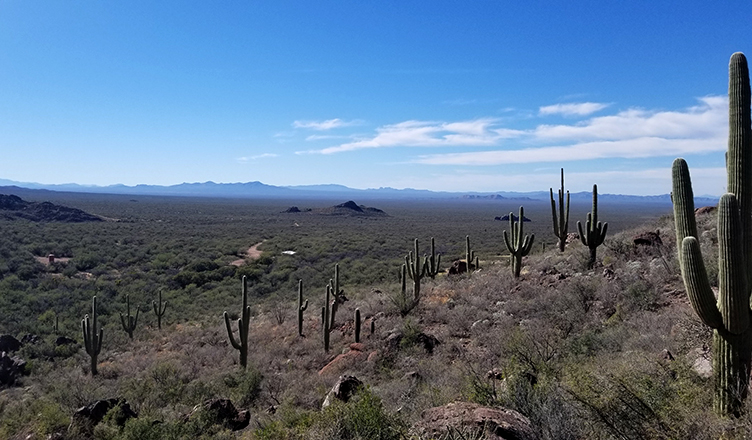
01/04 TRAVEL TO TUCSON
This was my first time on a plane; I did not even sleep the night before. On our flight to Tucson, there were not many clouds, so I was able to see how the terrain is so different than Pennsylvania with the desert and the cacti. I am so used to seeing a sea of green; it was so amazing to see such a difference.
– Caitlyn Hall ’20
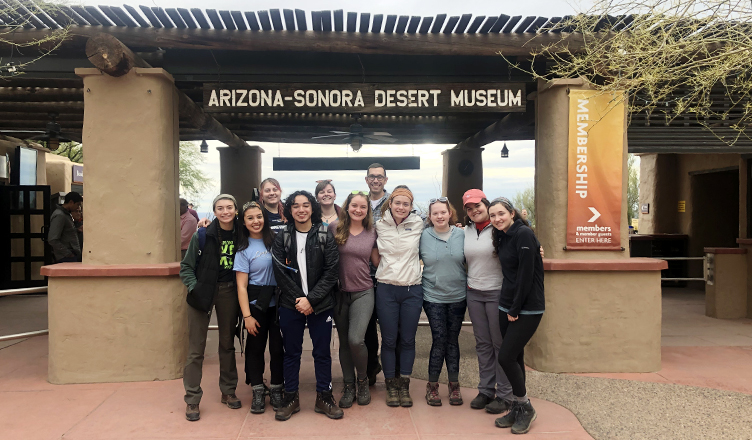
01/05 INTRODUCTION TO THE SONORAN DESERT
The day started in Gates Pass where Dr. Kilgore taught us how to identify all the native plant species in this region, such as prickly pear cactus and ocotillo. The weather by this point was amazing – cannot beat Arizona weather in January! We then went to the Arizona-Sonora Desert Museum in the afternoon. The views from the overlooks were incredible, especially with all the tall, armless saguaros popping out randomly into the sky.
– Erin Herock ’21
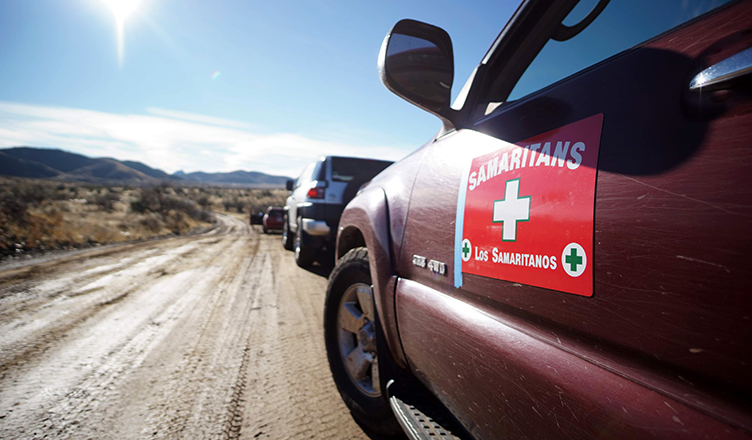
01/06 LOS SAMARITANOS TRAINING
One of the founders of Los Samaritanos is Reverend John Fife ’62. The mission of Los Samaritanos is centered around providing humanitarian aid, primarily food, water, and medical assistance, to migrants crossing the Sonoran Desert, while respecting legal authorities and private land boundaries.
Before we could venture out to the Borderlands we had to learn proper first aid that we would need and protocol for interacting with Border Patrol agents and migrants, along with a brief history of Los Samaritanos.
Los Samaritanos provides water and food at specific geolocated drops, as well as conducts search and rescue missions. Each vehicle is identified by a white medical cross.
– Megan Bollman ’20
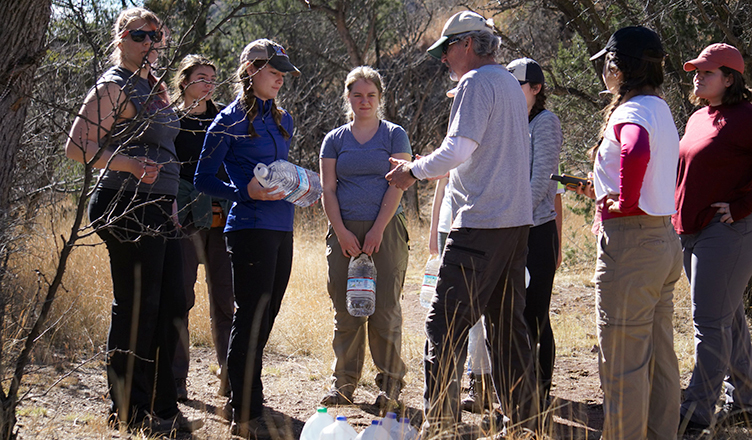
01/07 FIRST DAY IN THE FIELD WITH LOS SAMARITANOS
We went on our first water drop with the Samaritans, driving about one and a half hours to Arivaca, Ariz., right along the U.S.-Mexico border. We divided ourselves into three 4×4 vehicles, as we would be driving on rough terrain, and packed each of the vehicles with gallons of water, food packs, and supplies such as blankets and socks.
When we arrived at Arivaca, we followed common migrant paths, which the Samaritans had previously mapped out, each of us carrying the gallons of water by hand or in our backpacks. It made for a difficult journey, as we were hiking uneven terrain while carrying heavy supplies, and that helped us realize just how hard the Samaritans work.
By the end of the expedition, we had left some 30 gallons of water at specific sites. The Arivaca area was extremely dry—one of the most arid areas we explored while in Arizona. This makes the water left by the Samaritans that much more precious to dehydrated migrants, and more often, the difference between life or death.
– Sofia Carrasco ’21
This was an eye-opening experience as it was just something I heard on the news, never thinking that I would ever be involved and immersed in it. I have learned that empathy, knowledge, and understanding are important to decision making and having opinions on issues.
— ERIN HEROCK ’21
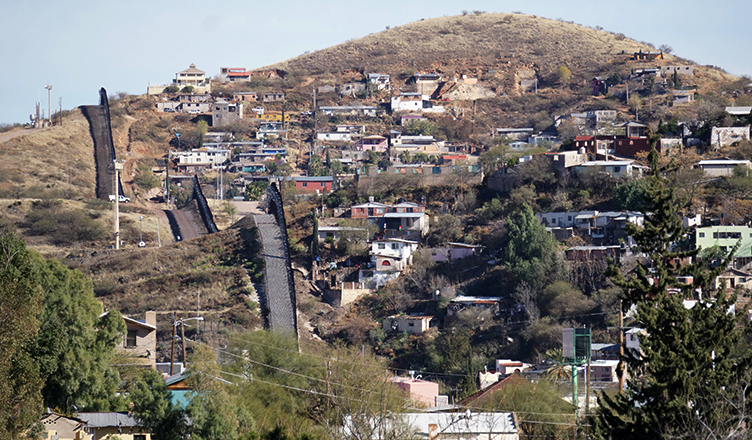
01/08 BORDER TOWN TRIP
We visited Nogales, a very busy U.S. port of entry. I have not been to a border town for nearly eight years, and I’m pretty sure things have drastically changed over the years.
Before reaching the actual port of entry, you can look up and see the beautiful hills surrounding Nogales. However, despite the beautiful scenery, walls are separating the U.S. and Mexico, and they stretch for miles to the west and the east.
At the actual port of entry, the port was massive with high walls and cameras everywhere. Traffic going into the U.S. was going very slow, mainly because the process of coming in and getting checked may take a while due to all the safety protocols. Dr. Kilgore approached a U.S. troop who was stationed near the port of entry and asked if we could observe the process of checking border crossers but was denied. Instead, we walked on the road next to the border wall covered with razor wire and saw hundreds of crosses for named and unnamed children and adults who have died trying to cross the border. As we were walking, a military Humvee and transport truck passed by us on their way to repair loops of razor wire that had been moved to allow for people to cross the wall.
– Kenneth Jimenez ’21
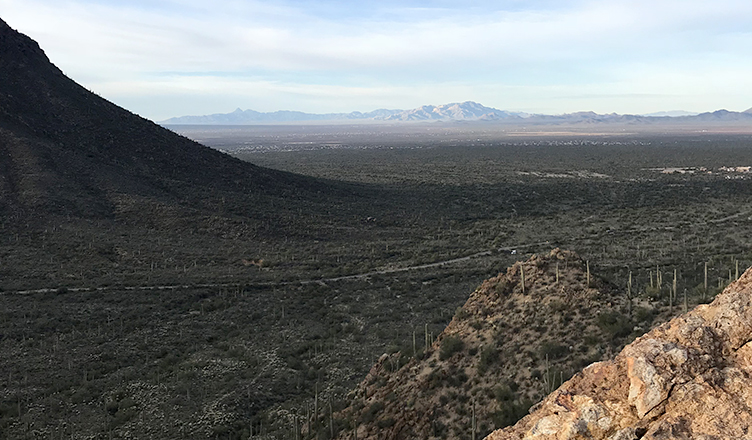
01/09 HIKING PICACHO PEAK
Picacho Peak is the remainder of a volcanic flow that eroded away more slowly than the surrounding rock. It has been used as a landmark since prehistoric times because of its distinctive shape rising more than 1,500 feet above the desert landscape.
The trail to the top of the peak is not very far in terms of distance, but it is one of the most physically challenging climbs that I’ve done, both in the effort it took to walk up the inclines and in the thought that I needed to put into my movements. The second half of the climb required us to climb with the assistance of steel cables drilled into the rock because of the slope. We had to pay attention to how we moved in relation to others, while still keeping a steady pace in order to reach the peak and get back down before the park closed at sunset.
A climb like this can kind of make you emotionally raw—you focus on reaching the top and on things like foot placement and continuing to walk when your legs are burning, and then when you reach the top, you’re struck by how beautiful the desert is and how small you are. As I was walking down the final stretch in the shadow of the peak, I turned around and looked up at the top, and surprised myself with the fact that I climbed it.
– Kirsten Yatsko ’19
Here at W&J, I am heavily involved in the Conflict & Resolution Studies program and have gone abroad to Ireland before to witness areas in conflict. This trip provided me an opportunity to see another conflict first hand, but domestically.
— MEGAN BOLLMAN ’20
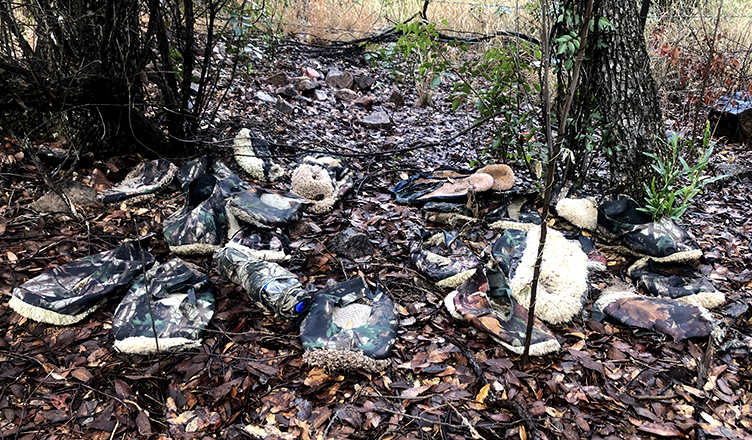
01/10 EXPLORING NEW MIGRANT PATHS WITH LOS SAMARITANOS
The border fence at the port of entry near Sasabe, a small village over an hour south of Tucson, had three rows of barbed wire and there were not as many people passing through here as there were in Nogales. We drove on dirt roads to a water drop point that is really close to the border and found so much water left there. There was evidence of immigrants passing through there because some of the water jugs left behind were drunk out of and some of the food that had been left was eaten. Some of our group went exploring and found carpet shoes that immigrants wear so they do not make as much of an imprint on the desert floor.
– Caitlyn Hall ’20
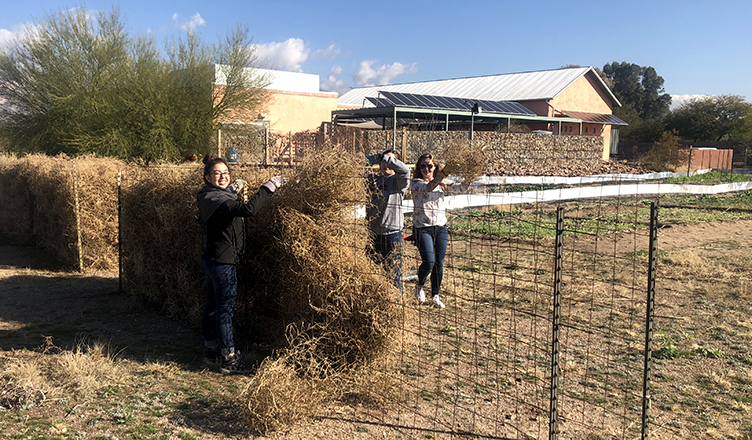
01/11 VOLUNTEERING AT A SEED BANK
We met Michelle at Native Seeds/SEARCH (NS/S) in Tucson to learn about the question, “What is a seed bank?” She explained that NS/S is a seed bank nonprofit, preserving locally cultivated genetic diversity of agricultural crops and promoting low-impact and indigenous agricultural practices. They typically distribute their seeds to Native American tribes when requested, but also sell seeds online and in a retail store.
We toured their seed bank facility and got to see where the magic happens: a refrigerated room with shelves inside, lined with hundreds of thousands of seeds. Their place of storage is kept cold, dark, and dry to help prevent sprouting. We witnessed one method of processing seeds called wind winnowing, essentially dropping seeds and extra attachments in front of a fan to separate the light extra parts from the heavier seeds.
We volunteered the rest of the day and built wind-breaker walls out of Russian thistle, an invasive plant that grows throughout the region. We used wire and T-posts to keep the pulled plants contained in the fence…how sustainable! This was a lot more fun than I was expecting, although I still keep finding thistle in my boots!
– Erin Herock ’21
When I was in high school, we watched a documentary in my Spanish class that followed a few children migrating from Central America through Mexico and into the United States. One of the main characters looked exactly like my little brother, and I couldn’t imagine their lives being so hopeless that they decide to leave their families at such a young age. Completing a daily journal as part of the course really illustrated to me the immenseness of the entire issue. Every day I was astounded by the amount of information I was reflecting on and attempting to absorb. Every person we spoke to, regardless of whether or not they were an expert or a professional, had a story and insight. Participating in this travel course really was just my first step outside of my comfort zone and has allowed me to feel confident to reach farther and continue growing as a global citizen.
— LILY BONASSO ’19
01/11 WITNESSING OPERATION STREAMLINE
This day in particular was a very emotional day for me as we witnessed Operation Streamline, which are “quick” trials on undocumented immigrants who face criminal prosecution and potential prison sentences in addition to formal deportation and removal from the U.S. As we entered the courtroom, there was already a group of migrants with headphones (for translation purposes), handcuffs, and shackles.
Their trials went by quickly. The judge states their name, their crime — illegal entry to the U.S. — and their estimated sentence time. As the translator speaks to them through the headphones, many will just say “Yes,” confirming the case and accepting the punishment. The trial went on, and more and more groups of migrants came in to hear their sentence.
Most of the migrants were from Mexico and Guatemala, but a group of six Ecuadorians also went on trial. Ecuador is located in South America, and I can only imagine what these migrants went through to get here. Not only their journey was longer, but also how did they manage to go through a rainforest environment to the dangerous deserts of Mexico? Did they give up a lot of their savings or property to get here? What sacrifice did they make in order to make this journey, just to get caught near the border?
At the end of the trial, 75 migrants were tried, convicted, and sentenced through Operation Streamline. However, a group of Guatemalans were dismissed since they spoke a native language for which the court did not have a translator.
– Kenneth Jimenez ’21
01/12 DAY HIKE TO WATERFALLS AND A NIGHT IN THE CITY
The longest hike of the trip was a 6-mile loop to and from Bridal Wreath Falls in the foothills of the Rincon Mountains. Because of the trail’s location, the only things you could see for most of the hike were the desert and the mountains themselves, covered with cacti, wildflowers, mesquite trees, and grasses. The city of Tucson was hidden, although we were only a short drive from the edge of town.
The trail we walked led to a waterfall fed by snowmelt from the top of the Rincon Mountains. I made the somewhat impulsive decision to fully submerge myself in a pool of snowmelt at the base of a waterfall. The change in temperature was enough to take my breath away.
– Kirsten Yatsko ’19
01/13 HIKING WALKER CANYON WITH LOS SAMARITANOS
With the expert guidance of Bob Kee from Los Samaritanos, we ventured up Walker Canyon to the border of Mexico and the U.S., passing through heavy flood zones littered with remnants from cattle tanks and passing migrants.
Many immigrants travelling into the United States pass through this area, making it a highly active trail, and a heavy surveillance area for the Border Patrol. The occasional drone flew overhead, and video cameras were hidden within the trees.
– Maggie McQuaid ’20
The trip showed me that this big issue with the border is actually two separate issues, a humanitarian one and a security one, and should be treated as such. You truly have to see it first-hand to understand it.
— KAILEE HAVRDA ’20
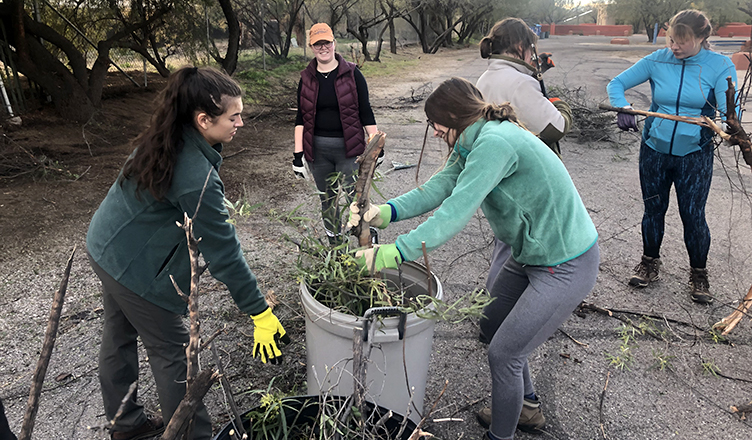
01/15 SERVICE AT OUR GIRL SCOUT CAMP
To thank our hosts, the Girl Scouts of Southern Arizona, we contributed service to the Hacienda Program Center where we stay. This year, our project was pruning trees and bushes near the entrance for aesthetic and safety reasons. Yolanda, the property manager at the Hacienda, worked with us. Because there were 12 of us working, we were able to achieve in an hour and a half what would have taken the Hacienda staff two full days of labor. We were comfortable with each other at this point, and had fun while we carried out our tasks.
The group went out to dinner with Yolanda that evening. We greatly appreciate her friendliness and hospitality, and it was nice to be able to spend time with her and give back to the organization that facilitated our stay in Arizona.
– Kirsten Yatsko ’19
01/16 ENVIRONMENTAL EFFECTS OF THE BORDER WALL
We met Dan Millis at Sierra Club in Tucson to talk about the Borderlands Project. It was really cool to meet a character I read about in my assigned book The Death of Josseline. He was the No More Deaths volunteer who found Josseline’s body in Margaret Regan’s book, playing an important role in this tragic but powerful story.
We learned about the Real ID Act’s impact on the environment related to national security. This act overrules Federal environmental, cultural, and historical laws for border enforcement activities, including wall construction. Unfortunately, the border wall threatens 93 endangered species such as jaguars and ocelots.
– Erin Herock ’21
I am the daughter of an immigrant who was able to obtain citizenship fairly easily, and I also live in Pennsylvania, a northern state far from the U.S.-Mexico border. While I have been extensively exposed to issues concerning the border and immigration policy through class, the news, and the community I was raised in, being able to actually go down to the border and witness different facets of the situation for two weeks was an invaluable experience. I now feel more educated and informed.
— SOFIA CARRASCO ’20
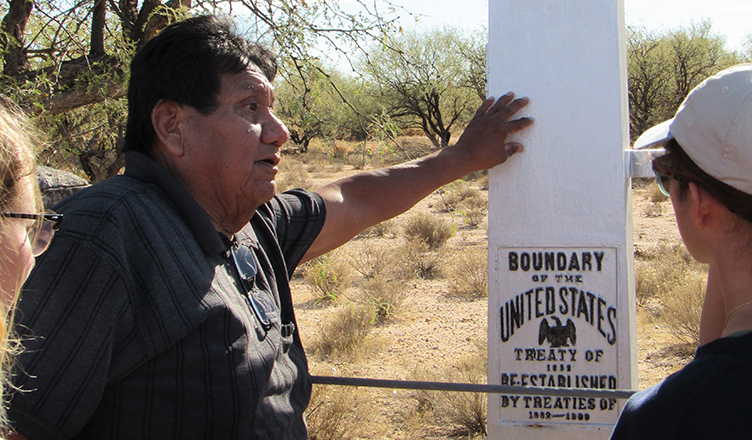
01/16-01/17 LEARNING ABOUT THE INDIGENOUS PERSPECTIVE
As we drove deeper and deeper into the Tohono O’odham Nation (TO Nation) reservation, we observed poverty and simple living in a beautifully wild land.
We were lucky enough to stay at the Himdag Ki:i Cultural Center, curated and designed by Bernard Siquieros, a museum filled with a rich history of an indigenous people who had only just developed a written version of their language within the past hundred or so years, and had preserved their history through oral traditions and calendar sticks to mark important moments in history.
Once we left Himdag Ki:i, we went to the border that separates the TO Nation from Mexico to the United States where we had the opportunity to meet with the District Co-Chair and talk about border immigration and its relationship with the TO Nation. We learned the history of privatization of TO lands by Mexican ranchers and how the U.S. government had split the land in half. We witnessed the lack of care that was put into creating the unwanted form of a vehicle barrier that runs straight through the Nation’s lands.
– Maggie McQuaid ’20
On previous trips, students have been able to meet with the U.S. Border Patrol, but, due to the partial government shutdown, agents were not available to meet with the group.
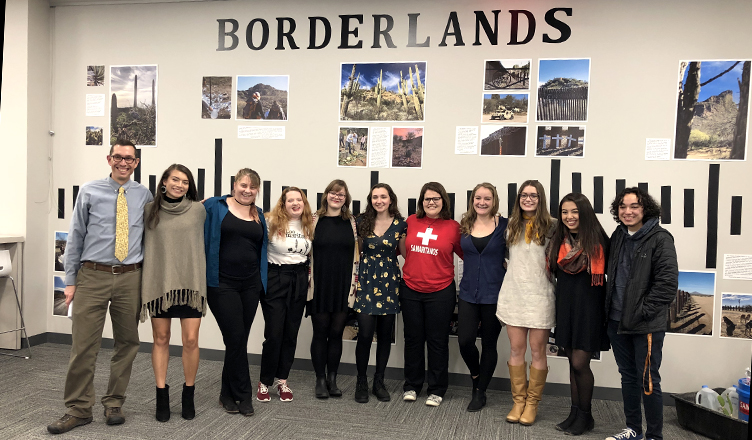
03/01 CURATING OUR EXPERIENCES
Upon return from the Sonoran Desert, we brought back memories of the terrain, stories of our venture, rocks from our favorite sites, and countless stickers to remind ourselves and others of our trip. However, most importantly to us, we brought back initiative and desire to create a photo exhibit in the Clark Family Library at W&J.
Titled “Borderlands,” this exhibit aims to depict the sites we saw, people we encountered, and knowledge we learned while in the Borderlands. It features photos taken by us, the students, and those of Jake Meyers ’15, who accompanied us during the trip to document and supplement our experience.
The exhibit’s simple title was chosen in efforts of drawing attention to the general issue. Our class was incredibly interdisciplinary, with topics covered ranging from biology to public policy.
While creating the design and choosing photos with my classmates for the exhibit, I hoped for one thing above all: that this exhibit provide needed exposure to a beautiful region and its inevitable tie to border policy.
The center of the exhibit depicts images of the innumerable saguaros we encountered and the agaves we helped roast, while adjacent photo clusters feature militarization of our border wall, the mountains we climbed, remains of belongings in the desert, and the Tohono O’odham Nation. The clusters stem from a simulated wall, reminding us that the region depicted in the photographs lies both above and below the border, as do the issues and the society found within it.
The final twenty-four hours before the exhibit opening was reminiscent of the small but intimate community my classmates had made in Arizona, brought back to share our vision with W&J. We worked until the library’s closing at 2 a.m., some ordering the photos while others calculated the oscillations for the simulated wall.
Through our trip and the opening of this exhibit, my classmates and I agreed that no matter what students’ or the public’s opinions may entail, the complexity of our boundary line and the societies surrounding it must not go unnoticed.
– Adriana Rodriguez-Ruiz ’20
This fall, Professor Kilgore and Associate Professor of Spanish H.J. Manzari, Ph.D., are hosting a Borderlands Series featuring speakers who are familiar with immigration at our southwestern border. Reverend John Fife ’62, former Moderator of the General Assembly of the Presbyterian Church (USA) and cofounder of the Sanctuary Movement, No More Deaths, and Tucson Samaritans, will anchor the series in October.



